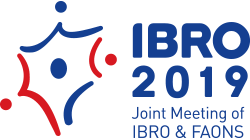Scientific Program
Program & Abstract Search
Home > Scientific Program > Program & Abstract Search
Luncheon Seminar
- Organized by National Research Center for Dementia in Chosun University(NRCD)
- Date Wed. (Sep. 25) 12:40 ~ 14:30
- Room 306, 3F
- Title 1. Incorporation of Novel Biomarkers to transform AD from a diagnosis of exclusion to a diagnosis of inclusion.; 2. Multimodal biomarkers for early diagnosis of Alzheimer's disease; 3. Distinctive roles of Ataxin-1 in Alzheimer's disease and spinocerebellar ataxia type 1
- Speaker 1. MARWAN NOEL SABBAGH (Cleveland Clinic Lou Ruvo Center for Brain Health); 2. KUN-HO LEE (National Research Center for Dementia, Chosun Univ.); 3. JAE-HONG SUH (Havard Medical school, Massachusetts General Hospital)
Brief Description
1. 12:40-13:20
MARWAN NOEL SABBAGH (Cleveland Clinic Lou Ruvo Center for Brain Health)
2. 13:20-13:50
KUN-HO LEE (National Research Center for Dementia, Chosun Univ.)
3. 13:50-14:20
JAE-HONG SUH (Havard Medical school, Massachusetts General Hospital)
1. Historical medical evaluation of dementia due to AD is inaccurate 27% of the time even with the most expert evaluation. AD has been historically a diagnosis of exclusion. Technology is becoming available that greatly improves AD diagnostic accuracy. Here we propose a novel algorithm that incorporates: a structured history; an aggregate risk assessment; a cognitive screening measure; a thorough neurological examination incorporation of biomarkers such as ApoE and MagQu IMR. This approach has the potential to improve the accuracy of a diagnosis of dementia due to AD to >90% without escalation of costs.
2. Alzheimer’s disease (AD) is a genetically complex disease and the most common form of dementia among elderly, accounting for 60-80% of dementia cases. The prevalence of AD is estimated to be approximately 13% among persons over age 65 and rapidly increases to 45% among those over age 85. For early identification of subjects without clinical symptoms at elevated risk, we have collected multimodal biomedical big-data including genomic variants, structural Magnetic Resonance Images (sMRI), amyloid-Positron Emission Tomography (A-PET), neuropsychological test result, and clinical diagnosis from the Korean participants aged 60 or above since 2014 (the total number of participants is about 12,000). Based on these multimodal datasets, we have focused our attention to reveal genetic risk factors responsible for AD development. We showed that the ethnic variability in AD/ Apolipoprotein E (APOE) ε4 allele association results from the difference in APOE promoter polymorphism. In addition, We performed genome wide association study (GWAS) with multi-dimensional endophenotypes, i.e., sMRI and PET images to identify genetic risk factors for AD carrying no APOE ε4 allele. The most potent candidate we identified is a genetic variant in PRDM gene, strongly associated with brain cortical atrophy and amyloid burden. Additional integrative translational and reverse-translational approaches revealed that the role of PRDM in AD development promising.
3. Expansion of CAG trinucleotide repeat in Ataxin-1 gene (ATXN1) is known to cause spinocerebellar ataxia type 1 (SCA1), a neurodegenerative disease that impairs coordinated movement. Recent genetic studies showed that ATXN1 is also associated with Alzheimer's disease (AD). In the present study, we demonstrated that loss of Ataxin-1 function
increases BACE1 transcription in AD-vulnerable brain region, and produces AD-related phenoyptes in the brain. In SCA1 mice, we discovered that polyglutamine-expanded mutant Ataxin-1 causes deficits in axonal targeting and selective neurodegeneration in hippocampal CA2 region.
* Registration is not required.



